
From the snow in the mountain pass of Dresden to Prague, to the fruit trees in blossom cradling our van, to the skyline of the city, Prague has been scenic all the way.
Sadly, the Dresden-Prague road was dotted by little sheds/cabins with prostitutes sitting in the windows, standing in front of the cabins wearing little in the cold, inviting truck drivers in. You don't see that every day.
On April 26, we found our way into downtown Prague, an easy tram-ride away from the campsite. Mark was struck by the unusual use of Lenin for commercial purposes. I [M] have only seen Lenin used this way (on our trip) in the Czech Republic. And, to have Angeleno Frank Zappa and Lenin together, made me [M], feel right at home.

A Yom haShoa reminder, seen over the shoulder of the man near us on the tram:

A young man at the Tourist info shop, implied: There's nothing beautiful in any of the synagogues, after all, Judaism (not his words) is an-iconic.
We began with our visit to the Jewish Museum which includes several sights--including the actual synagogues of the old Jewish "Quarter":
No matter how many Jewish museums you visit, there's still more to see and learn, including for us here:
Each synagogue building plays a different role in the totality of "The Jewish Museum Of Prague". They are numbered and you are "expected" to walk from one to the next and sometimes the path crosses itself. Fortuitously, we happened to be at the Meisel synagogue (the first in the series) when we purchased our tickets.

Debbie had learned that the Prague Jewish Museum collection had been created by the Nazis to create a collection of Jewish objects for what they expected would be the extinct Jewish people. Indeed, this museum was first created by Jews, and during the War, Jews asked that it continue to collect. The Museum was closed when the Nazis occupied Prague in March 15, 1939. Then it became a warehouse for stolen Jewish property. Jewish representatives argued for a central institution to house the Judaica. The Nazis approved,
"albeit motivated by what remains unclear"
read the brochure and the text in the museum. After the war a lot of the items were returned to the respective communities from which they had been stolen. Ownership of the museum was returned to Czechoslovakia in 1950; only in 1994 were the collections returned to the federation of the Jewish communities in the Czech Republic. The old synagogues of Prague were then organized under the auspices of the Jewish Museum and the Maisel, Pinkas, Klausen and Spanish Synagogues were renovated.
Prague seems to have had an important role in the development of the clock. We saw a few examples our second day in town, including the astronomical clock which presents the apostles in a glockenspiel on the hour. However, Mark has always been intrigued by this particular clock... the only Hebrew alphabet clock (on the Jewish Town Hall) that goes in the correct direction of the Hebrew language.

No, that is not Mark pointing to the clock, he's showing off his digital timepiece. And, he did not buy one of the wristwatch models available.
The building in the upper left corner of the picture is the Alt-Neu synagogue.
While on the subject of time
Up at the Castle is an early clock tower. It has two faces the hands of which function together. It turns out that the engineers had not yet figured out how to make two axles, one inside the other, to be able to control the hour hand and the minute hand on the same face.
Prague has at least one other clock of great interest. In fact, it is a tourist attraction all its own
The Prague Astronomical Clock
The time-keeping aspect of this clock is not what attracts the tourists. These come (about a thousand people were there for the 16:00 event that we experienced) to see the Apostles march in and out of the tower as each hour strikes.
In the other direction (from where you see Mark in front of his favorite clock), behind the photographer (Debbie) and to her right is a building with a facade that appears in the following photo. We were unable to learn what the building is and why it bears this iconography.

Interestingly no security checks in Prague at the museums and a very brief one at the Jubilee Synagogue.
We walked over a bridge to The Prague Castle.
.jpg)
The building on the left edge of this photo is the "official" Kafka museum, but, more on that later.
The path up to the castle is "guarded" by a continuous row of tourist item shops. We strolled in and around the castle, found the beautiful gardens, noticed the Barbie Doll Exhibit at the toy museum but no one could explain why it's there. We also happened on the construction of the old crane project, using medieval tools and techniques.
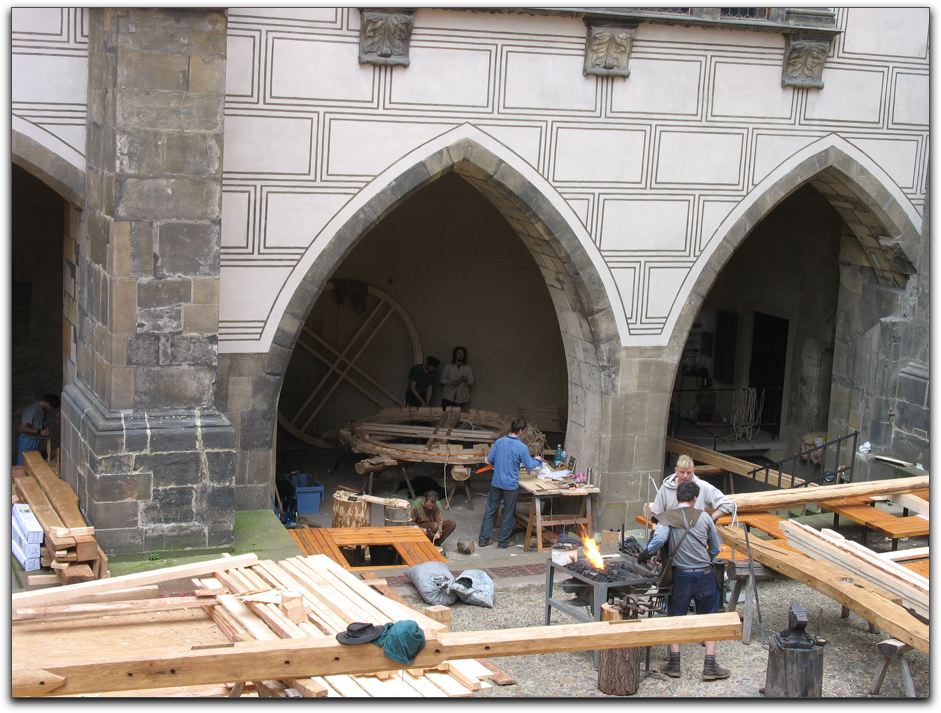
Then we walked back along the Charles Bridge, the first and oldest of the Prague Bridges, past the many shlocky stands, very touristy and crowded, imitative of the Ponte Vecchio of Florence.
Music abounds in Prague, so (keeping in tune with the theme of our touring) we chose a concert of Jewish music of Czech composers and music of Jewish composers in the Spanish Synagogue.
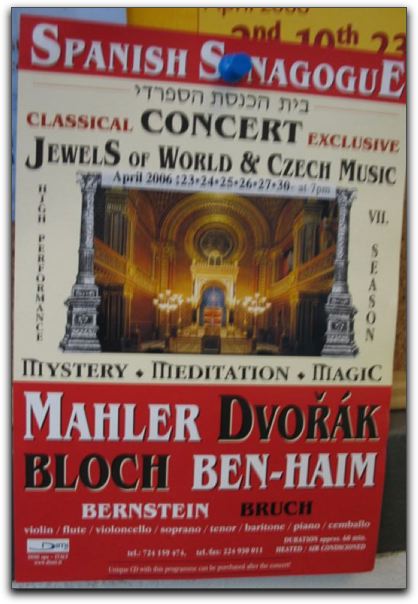
Surprisingly the acoustics were really good and the musicians quite accomplished as well.
As reported in the portrait of the day for that day:
We had a bit of a challenge determining Shabbat service times in Prague. In Berlin, we picked up a list of synagogues and service times easily at the exhibit at the Neu Synagogue. Mark had checked on line for the Prague liberal synagogues and didn't find the schedule. We had hoped to find a simple listing around the several Jewish Museum sites. The attendants there didn't speak English and were a bit "aiver batul" so we didn't think that would help. Our Jewish Museum brochure, however, listed the Jewish Educational and Cultural Center so we thought we would try that. Not only was it tough to find, given that several entrances to one building had the same address and that one entrance had two different numbers on it... is that #15 or #38? (we saw that a lot actually),
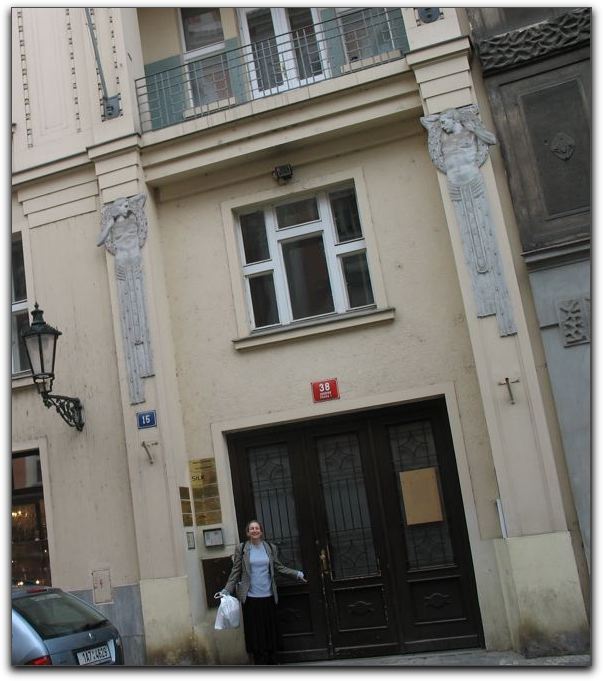
they did not have a handy list. One of the workers there simply printed out a list of the synagogues related to the Museum but without service times. He had no awareness of the liberal synagogues. So Mark used their computer to check the World Union for Progressive Judaism website and printed it out for the guy. This time the service schedule showed on Beit Simcha's website.
Apparently one of the liberal groups also meets at the Spanish Synagogue (so called because of the architectural style, not because it's attended by Sephardim). Mark also wanted information about "Horowice", having learned many years earlier from some books about Jewish geneaology, that the name "Hurvitz" may be related to that town. They suggested we go to the Reference Center of the Jewish Museum. We did. Despite these resources Debbie had a hard time getting a definitive answer to her questions about how many Jews live in Prague, how they affiliate, etc. The librarian at the Reference Center was not Jewish but very helpful. They have a small collection in the Reference Library, which we were happy to see includes Grace Grossman's book about Jewish Museums of the world, and a book listing all the towns in which there were Jewish communities before the Shoa. Mark had found a town with a spelling similar to "Horowitcky" a bit to the north west of Prague on one of the maps we had, and another town "Horowice" a bit to the south west of Prague. The woman at the Reference Center was able to find "Horowice" in her books, and printed out a description of the town and a detailed map of the local area to help us find it... later in our travels.
We saw Israelis everywhere and learned there may have been as many as 10,000 Israelis in Prague for the Final Four basketball games.
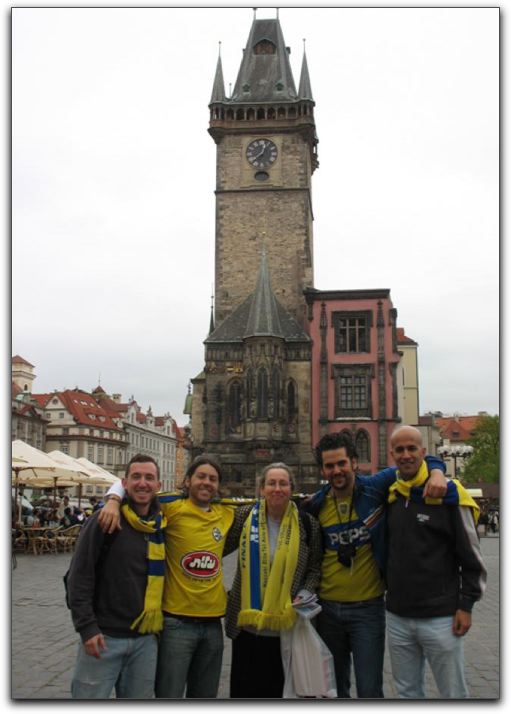
We were not able to get one of those scarves Debbie's wearing, but we scored some other souvenirs.
Israel made it to the finals for the 3rd/4th time but lost on Sunday night to Moscow.
To Beit Simcha, one of the liberal groups, for Shabbat services at the Jubilee Synagogue, another Moorish Style Synagogue. It turned out the American group was a singles tour and they had come without a rabbi. The local folks expected them to have one. So Debbie was enlisted by the tour leader to conduct the service, but of course she utzed Mark to join her. The singles group seemed to appreciate it and gradually warmed up. Sylvie Wittman, the the Wittman Tours Director, spoke briefly about the background of the Jubilee in the context of Reform Judaism, primarily that Prague has a proud history of Reform as one could see from the built in organ there, and that just recently the liberal community had been accepted by the Jewish community after a significant fight.
Amerikanizing Franz
or...The Path To The Castle Is Guarded By Tschachke Shops
or...Selling the Right to Swallow the Roach:

Many books have been written about Kafka and Prague. I doubt that I could add any hidush (anything new). However, I (m) had a couple of thoughts I want to share. Kafka's birth house (where he lived at least through his elementary education) lies at the edge of the old Jewish quarter, about twenty-five meters from the Meisel synagogue. What is now the "Old Jewish Quarter" is actually the result of an "urban renewal" and "gentrification" campaign that occurred while Franz was in his teens through his early thirties (I'm not certain of his dates). Very little of the Old Jewish Quarter remains other than the Alt-Neu, the other synagogues and the cemetery. There's a quote of Kafka's we saw around town in a number of places that gets translated differently almost every time.
We carry it in us.
The "it" gets translated variously (as "ghetto", etc.). The full quote suggests that "it" is "the Old Jewish Quarter" which was destroyed during his formative years and does not refer to Jews carrying "The Ghetto" (you know, the heavy concept with all it's negative implications) with them. This is a good moment to mention one of Mark's favorite books on this period of Jewish history: The Ordeal of Civility by John Murray Cuddihy.
Mary's Monster
No report of Prague would be complete without some reference to the Golem. Read Kavalier and Clay.
Mark has been collecting Golem materials for many years. He was able to add a bit more on this excursion.
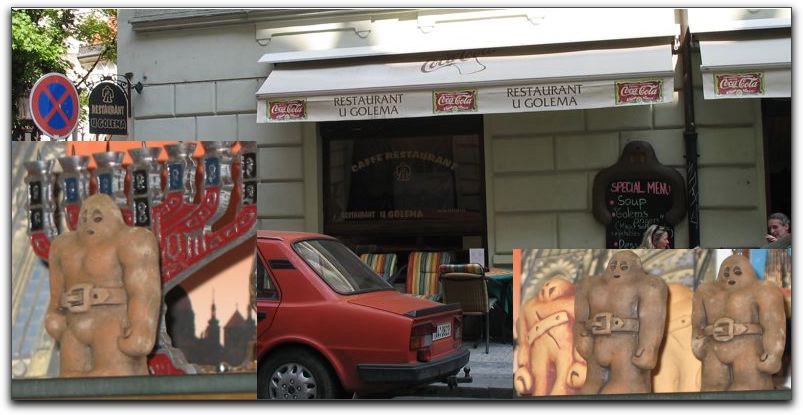
They come in about three basic shapes and two basic sizes (with slight variations).
Back in 1995 Mark wrote a Golem Chant.